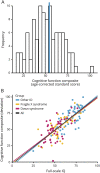Validation of the NIH Toolbox Cognitive Battery in intellectual disability
- PMID: 32094241
- PMCID: PMC7274932
- DOI: 10.1212/WNL.0000000000009131
Validation of the NIH Toolbox Cognitive Battery in intellectual disability
Abstract
Objective: To advance the science of cognitive outcome measurement for individuals with intellectual disability (ID), we established administration guidelines and evaluated the psychometric properties of the NIH-Toolbox Cognitive Battery (NIHTB-CB) for use in clinical research.
Methods: We assessed feasibility, test-retest reliability, and convergent validity of the NIHTB-CB (measuring executive function, processing speed, memory, and language) by assessing 242 individuals with fragile X syndrome (FXS), Down syndrome (DS), and other ID, ages 6 through 25 years, with retesting completed after 1 month. To facilitate accessibility and measurement accuracy, we developed accommodations and standard assessment guidelines, documented in an e-manual. Finally, we assessed the sensitivity of the battery to expected syndrome-specific cognitive phenotypes.
Results: Above a mental age of 5.0 years, all tests had excellent feasibility. More varied feasibility across tests was seen between mental ages of 3 and 4 years. Reliability and convergent validity ranged from moderate to strong. Each test and the Crystallized and Fluid Composite scores correlated moderately to strongly with IQ, and the Crystallized Composite had modest correlations with adaptive behavior. The NIHTB-CB showed known-groups validity by detecting expected executive function deficits in FXS and a receptive language deficit in DS.
Conclusion: The NIHTB-CB is a reliable and valid test battery for children and young adults with ID with a mental age of ≈5 years and above. Adaptations for very low-functioning or younger children with ID are needed for some subtests to expand the developmental range of the battery. Studies examining sensitivity to developmental and treatment changes are now warranted.
Copyright © 2020 The Author(s). Published by Wolters Kluwer Health, Inc. on behalf of the American Academy of Neurology.
Figures


Comment in
-
Finding a common path to the assessment of persons with intellectual development disorders.Neurology. 2020 Mar 24;94(12):507-508. doi: 10.1212/WNL.0000000000009132. Epub 2020 Feb 24. Neurology. 2020. PMID: 32094243 No abstract available.
